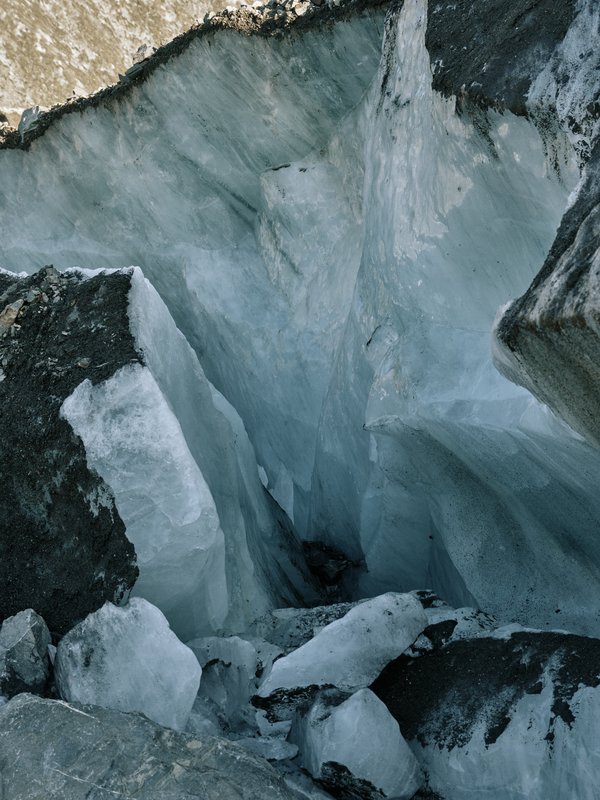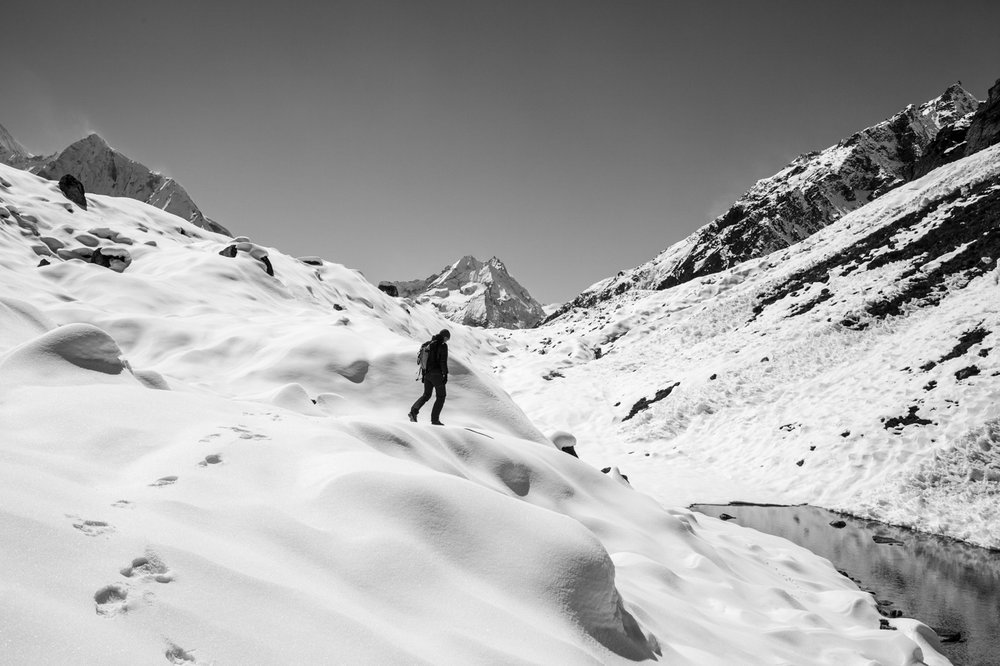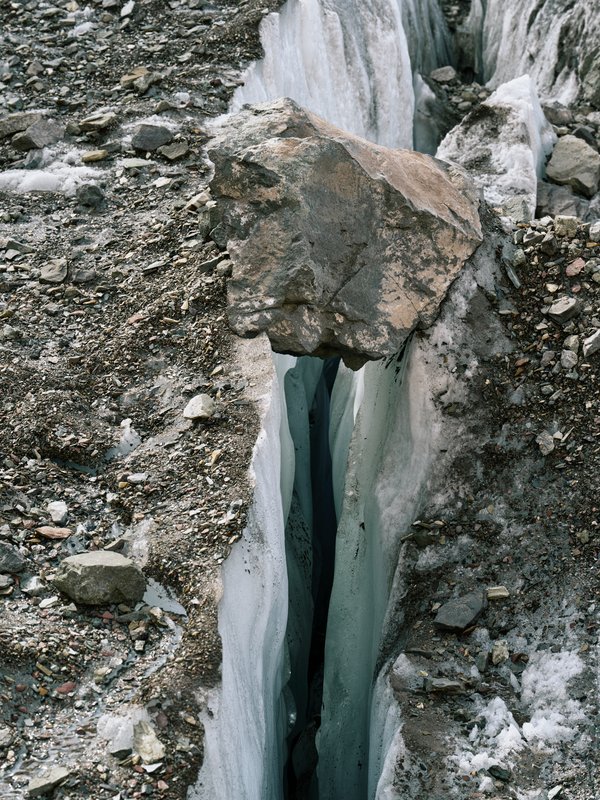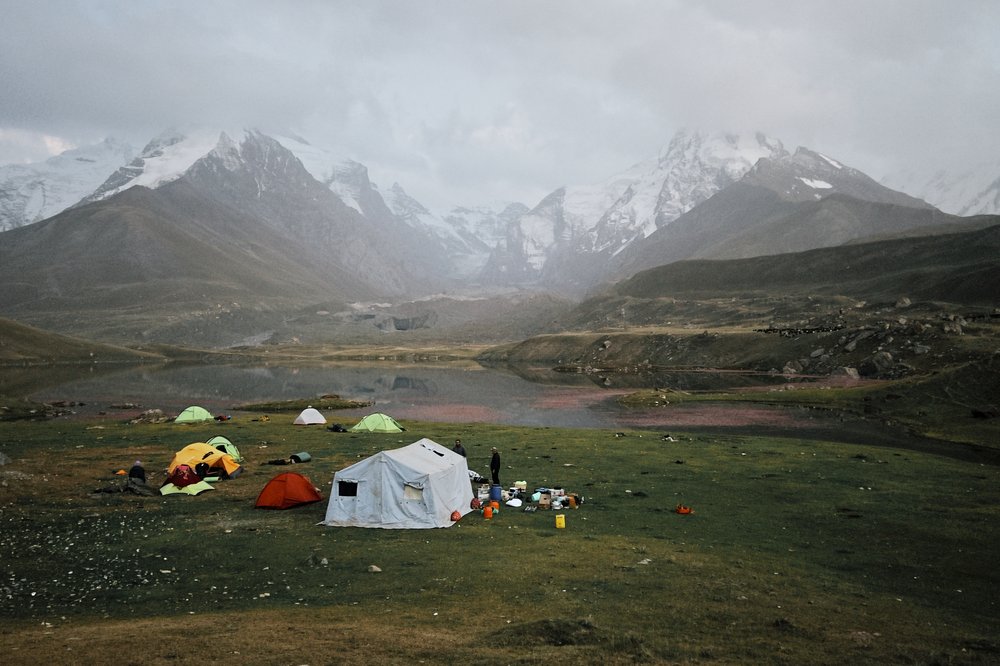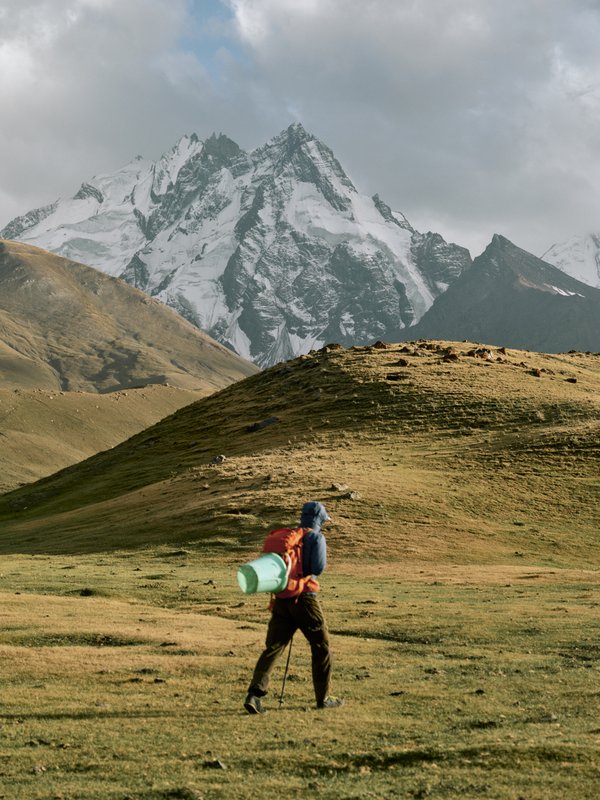April 29, 2024
The Glacier Researcher
C/O Vienna Magazine interview with ISTA Professor Francesca Pellicciotti
Glaciers are not only tremendously beautiful but also tremendously alive. They melt, cause sea levels to rise and trigger natural disasters, yet they are a crucial source of fresh water we hope to preserve. At the Institute of Science and Technology Austria (ISTA), the Italian-Swiss researcher and glaciologist Francesca Pellicciotti studies glaciers that—in contrast to global trends and a warming climate—appear to be stable or growing. A conversation about humility and the third pole.
In collaboration with C/O Vienna Magazine by Eva Holzinger.
“Mountains make my life better.”
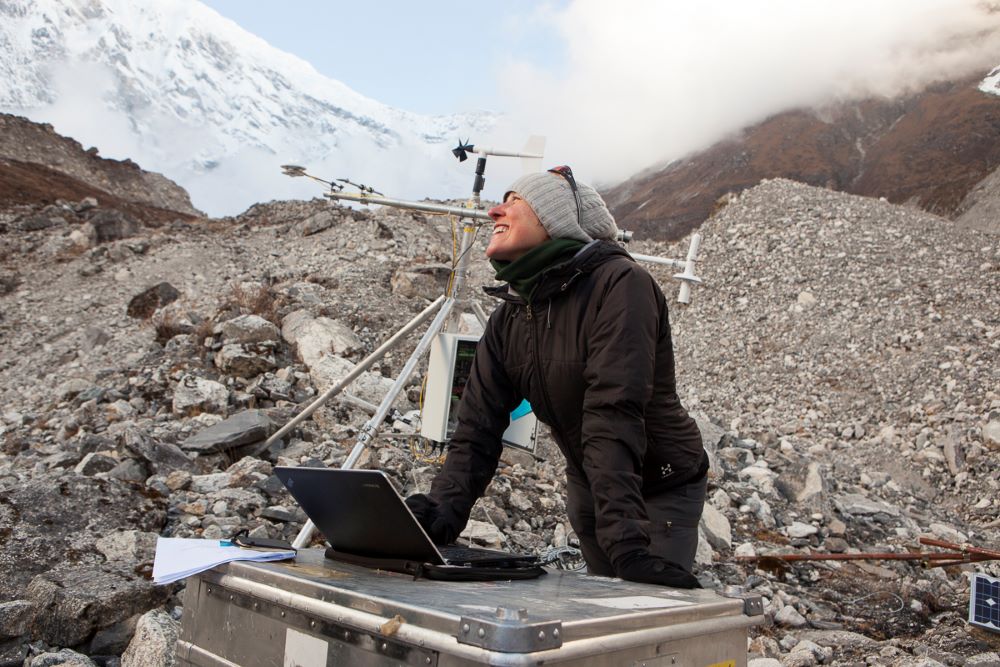
Eva Holzinger: Francesca, where does your fascination for glaciers come from?
Francesca Pellicciotti: From my father. He grew up in a small village at the foot of Gran Sasso. Gran Sasso is part of the Apennines, a mountain range that stretches through almost all of Italy, from north to south. My father loved the mountains he was born in. As a young man, he would often hike up the mountain all night, then ski down at dawn. He often took me and my two younger sisters to the mountains, and I remember skiing down slopes on his shoulders. He passed away in the summer of 2023, shortly before I moved to Austria. It was a painful farewell and a new beginning at the same time.
EH: How would you describe your relationship with the mountains?
FP: There is a kind of spiritual dimension to my relationship with them. I talk to them and they show me how powerful and fragile they are at the same time. Mountains make my life better.
EH: What amazes you most about glaciers?
FP: The consistency of the ice and the fact that they are often located in beautiful, untouched landscapes. Their majesty, their material. The fact that you have to walk many days and kilometers to reach them. The thin air, the effort required to reach them, the respect you must have for them. It is hard to explain why a glacier is so beautiful; its size and dynamics give it a special presence that you feel when you are close to it. They make you feel small.
EH: What does a glacier actually smell and sound like?
FP: You smell the thin air in the mountains. There is purity, visually and in all the senses. You can hear the sound of mountains: rock and water. Clean ice glaciers sound different from glaciers covered with debris. It’s a very particular sound, hearing the rocks shifting and colliding under your feet as you walk on them. Walking on rolling stones requires concentration and balance, it is like a meditation. When you walk on the ice with crampons, you also hear the thinnest ice on the surface being crushed by the crampon spikes. Sometimes we hear avalanches from higher glaciers bringing snow down into the valley. The air in the mountains smells fresh—and it’s usually very cold!



EH: Does a glacier melt one’s ego?
FP: Yes, glaciers certainly inspire a sort of humility in me. I have been at many places of excellence, and the Institute of Science and Technology Austria (ISTA) is one of them, full of great scientists, but scientists are often in a bubble, and a world of competition can feed your ego. It’s important to me to step outside of it from time to time and reconnect with our surroundings to protect the mountains. Mountains teach you humility and inspire you to act to protect them.
“There's now pizza and Coca-Cola at 3,000 meters in Nepal.”
EH: In Austria, a climate protection association organized a funeral on the Grossglockner in autumn 2023, where the Pasterze is in the process of losing its tongue. At around eight kilometers long, it is the largest glacier in Austria. Are you also mourning the loss of glaciers?
FP: When I study glaciers on-site, I feel very close to them. And naturally, when I am there, all I see is beauty. At that moment, I don’t feel any loss myself; they are just too vast, mighty and beautiful. But I grieve about the planet and its current state, and I grieve when I compare photos or data that show glaciers are getting smaller and “dying”.
EH: Don’t you get angry sometimes?
FP: I do. What makes me angry is the way we treat the planet, and an example of it is the rising mass tourism in Nepal, which destroys the mountains, their valleys, and thus the habitat of the locals. At 3,000 meters, you can now find pizza, Coca-Cola, bathtubs, and suitcases instead of backpacks. It’s painful for me to see, and it makes it more difficult to return to such highly frequented places that have lost some of their souls and beauty.
EH: How can glaciers and their reactions to climate change be studied?
FP: Basically, there are three important methods we work with to study the so-called cryosphere, which includes ice in all its forms, and landscapes containing ice or snow: We develop and use models, numerical models that can simulate the natural world physics; at the moment, we are working with integrated, so-called land surface models and then we combine them with the collected data from field research and satellite images.
EH: What does a glaciologist do on a glacier? What does your day-to-day work look like there?
FP: Our field plans depend on the specific research goals of the expedition, but often we try to characterize the melt, climate, and hydrological processes in the catchments where we work. For example, we install a weather station, measure river discharge, set up stakes to measure ice melt, and install time-lapse cameras to capture changes on the glacier. When we camp near the glaciers, we wake up early, have breakfast and then prepare the equipment for the day. We then have to hike onto the glacier to conduct the measurements and return in the late afternoon. Even after dinner, we often have a lot to do: sorting data, charging equipment, and planning for the next day. Evenings are the time to debrief, and then a nice time to relax or read, but usually, we go to bed early because since at such high altitudes it gets seriously cold at night and a warm sleeping bag is tempting.
“When I am close to glaciers, I see nothing but beauty.”
EH: What exactly can one learn from the satellite images you are also using?
FP: Satellite images are very useful because they provide us with information on a scale that is simply not achievable through on-site measurements. We use them to study snow conditions, the albedo of the ice—that is, how strongly the ice reflects radiation—as well as the flow velocity of glaciers, the characteristics of vegetation and ground cover, and even the mass balance, i.e., the health of the glaciers. We use our models as tools to understand these processes. For example, we can precisely examine the conditions that lead to the strongest ice melt in given regions or we use them to study the dynamics of the snow. They are also useful for looking into the past and predicting the future—how the glaciers have already changed and how they will look in the coming decades.
EH: What is the goal of your research?
FP: We study how glaciers and the cryosphere interact with a changing climate, and we study the hydrological cycle of the mountains of the world. We do simulations of how glaciers and water from the mountains will change in the future, and where non-linearities and tipping points can be expected. Our research has many facets, but if we understand glacier and snow processes and how they are changing, we can better predict how water resources will change in the future. We hope that people will be better prepared for this future and understand that we need to act now to preserve the glaciers and mountain environments—the environment in general.
EH: And what are you looking at specifically at the moment? Can you give us an example?
FP: We have different research focuses. My team and I, for example, are currently studying how glaciers provide vital water during mega-droughts. Mega-droughts are severe, multi-year droughts, like the ones that have already occurred in Chile. We simulate past droughts in Europe and the impacts of future mega-droughts on our computers. With global warming, glaciers are releasing more and more water. But: As they are also getting smaller, in the long run, they will release less and less water.



EH: 2023 was the hottest year on record. Glaciers react to global warming as “global fever thermometers”. They show us how much and how quickly the climate is changing!
FP: If this continues, there will eventually be very few glaciers in Europe.
“A feast for climate change deniers!”
EH: However, you are currently studying glaciers that are growing. Is the “eternal ice” not a thing of the past already?
FP: The Pamir and Karakorum Mountains are the only region where glaciers are not losing mass or even grow. There is no such phenomenon anywhere else in the world. It is located in a region of High Mountain Asia (shortly HMA): Central Asia. The HMA encompasses all major Asian mountain ranges, from the Himalayas across the Tibetan Plateau to the Karakorum and Pamir, and this region has been called the third pole, because it hosts the largest ice masses outside the poles. The significance of the project goes far beyond this region. Because the Pamir Mountains are a little-known and hardly explored area. The rivers originating from the glaciers supply millions of people in High Mountain Asia with water.
EH: Why are these glaciers growing?
FP: For glaciers to grow, more snow must accumulate on their surface than snow and ice are melting altogether. When that happens, the glacier gains mass and can grow over time. There are three hypotheses as to why or how this happens in the Pamirs: The first is that the monsoon may have changed, producing lower summer temperatures, which in turn reduces ice melt. Secondly, it could also have increased the snowfall in winter and spring, which leads to increased glacier mass. The third and most important hypothesis assumes that it is a phenomenon actually caused by humans. The Pamir-Karakorum region lies north of one of the largest irrigated agricultural areas in the world (in Pakistan). Scientists have suggested that the high evaporation of the soil and transpiration of the plants in this region is returning water to the atmosphere, which is then transported to the high elevations of the Pamirs, and also increases snowfall on the glaciers. We will find out what explains the Pamir-Karakorum anomaly in the next few years.
EH: Exciting phenomenon!
FP: Yes! Although one must be careful how one speaks about this fact because it is fodder for people who deny climate change. Global warming and growing glaciers, of course, do not fit together for climate deniers, but this is an isolated phenomenon in a world that is experiencing climate change.
EH: Your fieldwork has taken you from Nepal to Chile, from the Himalayas to the Andes. How did you end up researching so much in South American and Asian regions?
FP: In the Alps, much has been measured and analyzed for a long while already. In South America and Asia, there are much larger glaciers than in Europe, much less explored, and crucial for the water they supply to millions of people in downstream areas.
“It got me some enemies!”
EH: Tell us about your research trips to Nepal!
FP: Between 2011 and 2014, I traveled to the Himalayan region annually, and each year was an unique experience. You live and work in a Hindu society, which is divided into castes. There were very few female researchers there. At a conference in Kathmandu, I only met men from Pakistan, India, and China. I was there with two of my male colleagues, and I was then asked whose wife I was. I was unusual and needed to assert myself.
EH: How did you assert yourself?
FP: By actively building a connection to the local people, and promoting young people (male and female) who have curiosity and less prejudices. In Nepal, we worked with mountain guides and porters from the ethnic group of the Rai. They are strong, wonderful people; we worked in the Langtang Valley at the time, and tried to break casts and other barriers: we shared tea and food with them as well as our daily work, what was seen by a lot of the high casts as something you do not do. The following year, among other things, I returned to Nepal with three young female students as part of my team from ETH Zurich. Several of these attitudes (contacts with the local people, and low cast ethnic groups, a very democratic leadership style, bringing brilliant female scientists to the field) sparked surprise, and maybe also made me some enemies, especially with people from high casts. It is important for me to include the human aspect in science, and to give back to the local people an understanding of what we are working on and what we are researching.
“I have multiple homelands.”
EH: How did you explain your complex research to the local people?
FP: We built a documentation center and then handed over the management to a local women’s group. Since most women there are illiterate, we worked with a graphic designer and created posters that can be understood even without reading. We designed postcards that the women could sell to tourists. In 2015, an earthquake destroyed the village, including the stone house with the documentation center; many of the people we got to know there died.
EH: You grew up in Italy, lived in Switzerland for a long time, but also lived and worked in Newcastle, England. Where do you feel at home?
FP: Because of the many moves and regular travels, I am beautifully un-rooted in a way. I have multiple homelands and my heart in many places: in Italy, in Switzerland, in Chile, and in Nepal. I already feel very comfortable in Austria—I like Vienna. Culturally, I would clearly identify myself as Italian—and not just because I wave my hands a lot (laughs)!
EH: What grounds you?
FP: I dance tango and read books. I love plants—I also talk to them—and my friends. Culture is as important to me as science.
EH: Thank you for the conversation!

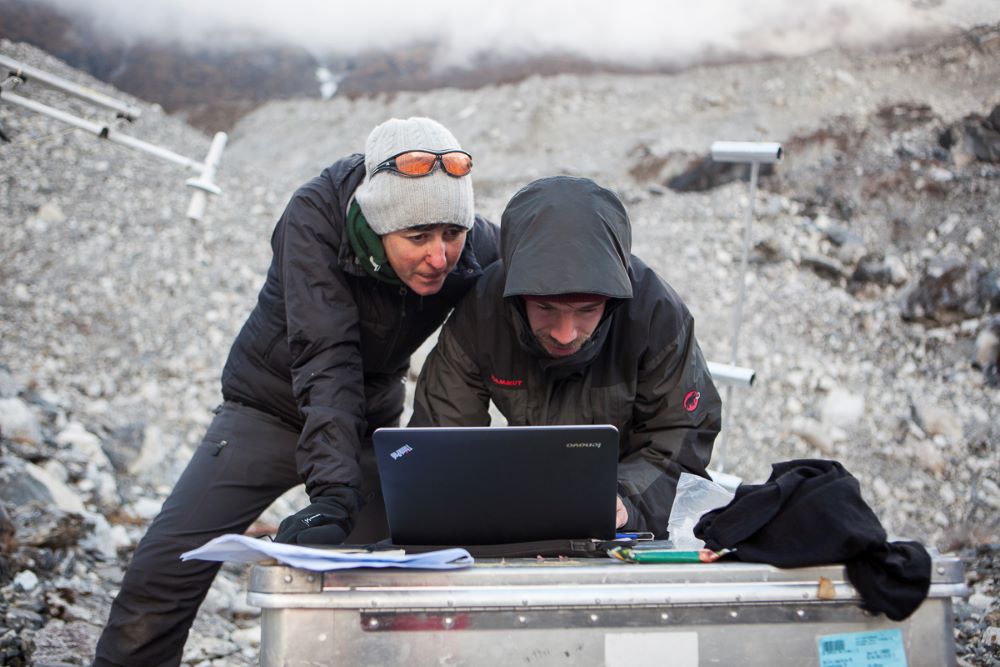
Exhibition: Walking on Rolling Stones
Growing glaciers: Not fiction, but reality. Can we dare to hope? An exhibition about research, emotions, and complex realities—the Institute of Science and Technology Austria (ISTA) invites you to take steps forward, with a research-focused look at our landscapes and prospects.
At the Institute of Science and Technology Austria (ISTA), scientists around Francesca Pellicciotti research glaciers that still seem to defy global warming. On the occasion of the first Vienna Climate Biennale, ISTA now takes the opportunity to give a stage to the field of glacier and hydrosphere research and, in collaboration with artists, to address their research results and science insights.
Galerie rauminhalt, Schleifmühlgasse 13, 1040 Wien
Opening hours 05.04.-14.07.2024: Tuesday-Friday, 12:00-19:00 and Saturday, 10:00–15:00

